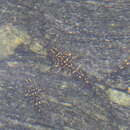tr
kırıntılardaki isimler


Parotocinclus is a genus of fish in the family Loricariidae native to South America. This genus is distributed through almost all hydrographic systems in South America from the Guyana Shield drainages and Amazon Shield tributaries to the coastal drainages of eastern and southeastern Brazil, including the rio São Francisco basin.[1] Most species have the caudal peduncle oval in cross section.[2] It has been found that Characidium species may interact with P. maculicauda. The small Characidium will follow grazing P. maculicauda, which release particulate matter dislodged from the catfish's foraging.[3]
By an analysis published in 2005, Parotocinclus is not a monophyletic genus. P. jumbo is not closely related to P. maculicauda, but is positioned, instead, as a basal lineage of the subfamily Hypoptopomatinae. Additionally, P. collinsae is not closely related to Parotocinclus maculicauda and may be more closely related to the genus Hypoptopoma and four other genera. P. jumbo and P. collinsae may eventually be transferred to new genera.[4] P. bidentatus and P. muriaensis form a monophyletic pair of sister taxa that is more closely related to a subset of species of Parotocinclus (which includes P. maculicauda) than to any other genus of the tribe Otothyrini.[4]
There are currently 38 recognized species in this genus:
Parotocinclus is a genus of fish in the family Loricariidae native to South America. This genus is distributed through almost all hydrographic systems in South America from the Guyana Shield drainages and Amazon Shield tributaries to the coastal drainages of eastern and southeastern Brazil, including the rio São Francisco basin. Most species have the caudal peduncle oval in cross section. It has been found that Characidium species may interact with P. maculicauda. The small Characidium will follow grazing P. maculicauda, which release particulate matter dislodged from the catfish's foraging.